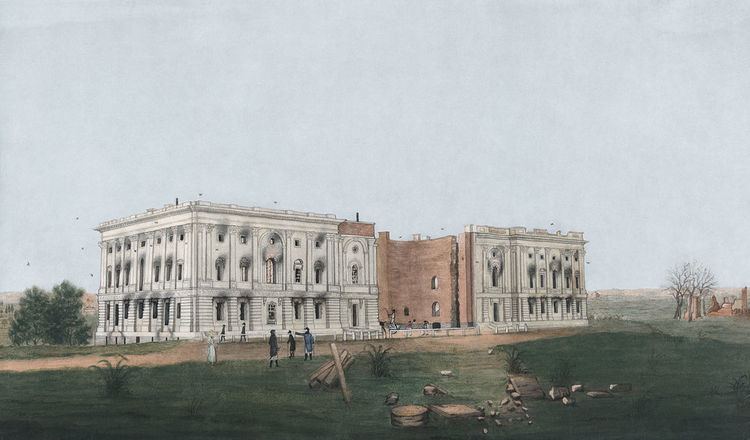The Thirteenth United States Congress was a meeting of the legislative branch of the United States federal government, consisting of the United States Senate and the United States House of Representatives. It met in Washington, D.C. from March 4, 1813, to March 4, 1815, during the fifth and sixth years of James Madison's presidency. The apportionment of seats in the House of Representatives was based on the Third Census of the United States in 1810. Both chambers had a Democratic-Republican majority. The first two sessions were held at the Capitol building while the third, convened after the Burning of Washington, took place in the First Patent Building.
September 10, 1813: War of 1812: Battle of Lake ErieOctober 5, 1813: War of 1812: Battle of the ThamesMarch 27, 1814: Creek War: Battle of Horseshoe BendJuly 25, 1814: War of 1812: Battle of Lundy's LaneAugust 25, 1814: War of 1812: Burning of WashingtonSeptember 11, 1814: War of 1812: Battle of Lake ChamplainSeptember 13, 1814: War of 1812: Bombardment of Fort McHenry at BaltimoreNovember 7, 1814: War of 1812: Forces under Gen. Andrew Jackson seized PensacolaNovember 23, 1814: Vice President Elbridge Gerry diedDecember 15, 1814: Hartford Convention convened through January 5, 1815, in which New England Federalists met to discuss their grievances concerning the ongoing War of 1812 and the political problems arising from the federal government's increasing power. Despite radical outcries among Federalists for New England secession and a separate peace with Great Britain, moderates outnumbered them and extreme proposals were not a major focus of the debate.December 24, 1814: War of 1812: Treaty of Ghent signedJanuary 8, 1815: War of 1812: Battle of New OrleansFebruary 17, 1815: War of 1812: Senate ratified the Treaty of Ghent, 8 Stat. 218The count below identifies party affiliations at the beginning of the first session of this congress. Changes resulting from subsequent replacements are shown below in the "Changes in membership" section.
Following the 1810 census, the size of the House was increased to 182 seats from 142.
President: Elbridge Gerry (DR), until November 23, 1814; thereafter vacant.President pro tempore: William H. Crawford (DR), March 4, 1813 – March 23, 1813Joseph B. Varnum (DR), December 6, 1813 – February 3, 1814John Gaillard (DR), from November 25, 1814Speaker: Henry Clay (DR), to January 19, 1814Langdon Cheves, (DR), from January 19, 1814This list is arranged by chamber, then by state. Senators are listed by seniority, and Representatives are listed by district.
Senators were elected by the state legislatures every two years, with one-third beginning new six-year terms with each Congress. Preceding the names in the list below are Senate class numbers, which indicate the cycle of their election. In this Congress, Class 1 meant their term ended with this Congress, requiring reelection in 1814; Class 2 meant their term began in the last Congress, requiring reelection in 1816; and Class 3 meant their term began in this Congress, requiring reelection in 1818.
The count below reflects changes from the beginning of the first session of this Congress.
replacements: 9Democratic-Republicans: 2 seat net lossFederalists: 2 seat net gaindeaths: 2resignations: 10interim appointments: 3vacancies: 3Total seats with changes: 15replacements: 13Democratic-Republicans: 17-seat net gainFederalists: 2-seat net lossdeaths: 6resignations: 13contested election: 1vacancies: 4Total seats with changes: 19Lists of committees and their party leaders.
Army Supply Contracts (Select)Audit and Control the Contingent Expenses of the SenateNational UniversityWholeAccountsBanks of the District of Columbia (Select)ClaimsCommerce and ManufacturesDistrict of ColumbiaElectionsPensions and Revolutionary War ClaimsPost Office and Post RoadsPublic ExpendituresPublic LandsRevisal and Unfinished BusinessRules (Select)Standards of Official ConductWays and MeansWholeEnrolled BillsArchitect of the Capitol: Benjamin LatrobeLibrarian of Congress: Patrick MagruderChaplain: John Brackenridge (Presbyterian)Jesse Lee, Methodist, elected September 27, 1814Secretary: Samuel A. OtisCharles Cutts, elected October 11, 1814Sergeant at Arms: Mountjoy BaylyChaplain: Jesse Lee (Methodist), elected May 24, 1813Obadiah B. Brown (Baptist), elected September 19, 1814Clerk: Patrick Magruder, elected May 24, 1813, resigned January 28, 1815Thomas Dougherty, elected January 30, 1815Doorkeeper: Thomas Claxton, elected May 24, 1813Sergeant at Arms: Thomas Dunn, elected May 24, 1813 
